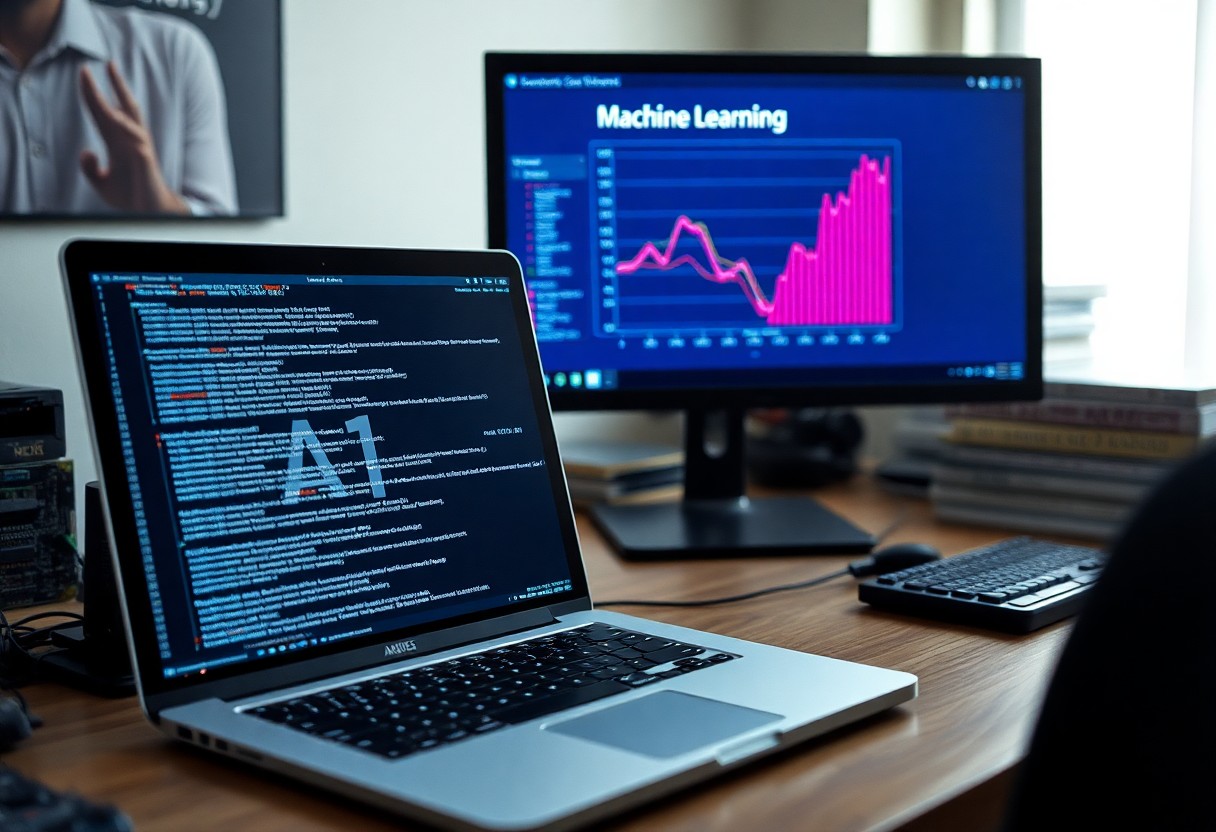You may often hear the terms Artificial Intelligence (AI) and Machine Learning (ML) used interchangeably, but they represent distinct concepts within software development. Understanding these differences is vital for leveraging the right technologies in your projects. AI encompasses a broader spectrum of intelligent behavior in machines, while ML specifically refers to algorithms that enable systems to learn from data. By grasping these nuances, you can make more informed decisions about implementing these cutting-edge solutions in your software applications.

Decoding AI: More Than Just a Buzzword
AI has evolved beyond mere hype; it embodies a range of technologies aimed at simulating human-like intelligence. This encompasses techniques from natural language processing to computer vision, enabling machines to perform tasks conventionally requiring human intellect. By leveraging vast datasets and advanced algorithms, AI can analyze patterns and make decisions, fostering innovation across numerous sectors.
The Core Concepts of Artificial Intelligence
Understanding AI requires delving into its foundational elements, which include machine learning, neural networks, and deep learning. These concepts focus on enabling systems to learn from data, adapt to new inputs, and carry out intelligent actions autonomously. You’ll encounter algorithms that evolve through exposure to data, creating predictive models that enhance decision-making capabilities.
Real-World Applications of AI in Software Development
AI-driven solutions are reshaping software development by automating coding tasks, improving testing accuracy, and enhancing user experiences. For instance, intelligent code completion tools assist developers by predicting the next line of code, while AI testing frameworks identify bugs with remarkable precision. These applications not only streamline workflows but also contribute to faster and more reliable software delivery.
In practical terms, AI applications such as GitHub Copilot have revolutionized coding by offering contextual suggestions and reducing the time spent on repetitive tasks. AI-powered chatbots enhance customer support by providing instant responses and troubleshooting tips, significantly improving user satisfaction. Furthermore, anomaly detection systems automatically monitor software performance, flagging issues before they escalate. These innovations not only enhance productivity but also elevate the overall quality of software development, allowing your team to focus on creative and strategic tasks.
The Machinery of Learning: Defining Machine Learning
Machine learning is a subset of artificial intelligence that enables systems to learn from data, improving their performance over time without explicit programming. By leveraging algorithms, machine learning identifies patterns and insights from vast datasets, thus facilitating decision-making and predictions across various applications in software development.
Types of Machine Learning and Their Uses
Machine learning can be broadly categorized into supervised, unsupervised, and reinforcement learning, each serving distinct purposes in software development.
- Supervised Learning: Classifies data based on labeled examples.
- Unsupervised Learning: Discovers hidden patterns in unlabeled data.
- Reinforcement Learning: Trains models through reward-based feedback.
- Deep Learning: Utilizes neural networks for complex data inputs.
- Transfer Learning: Adapts pre-trained models to new, similar tasks.
This variety enhances your ability to select the right approach for your specific project needs.
| Type of Learning | Use Cases |
|---|---|
| Supervised Learning | Spam detection, image recognition |
| Unsupervised Learning | Customer segmentation, anomaly detection |
| Reinforcement Learning | Game playing, robotics |
| Deep Learning | Voice recognition, natural language processing |
| Transfer Learning | Medical image classification, sentiment analysis |
The Role of Data in Machine Learning Processes
Data is the foundation of machine learning, driving the training and validation of models. Quality data determines the effectiveness of your algorithms, impacting their ability to generalize to new, unseen situations.
Successful machine learning hinges on not only quantity but also the quality of the data you utilize. Clean, diverse datasets enhance model accuracy and reliability, allowing for better predictions. For example, in supervised learning, labeled data helps guide the model during training, ensuring it learns the desired outputs. Conversely, in unsupervised learning, the richness and variability of your data set enable the discovery of valuable patterns. Hence, focusing on data preprocessing, including cleaning and normalization, will optimize the learning process and yield superior results in software development.
Intersections and Divergences: Where AI Meets Machine Learning
AI and machine learning intersect significantly but also diverge in distinct ways. Both fields aim to enhance computer systems but differ in scope and application. AI serves as the umbrella term encompassing all techniques that enable computers to simulate human intelligence, while machine learning specifically focuses on algorithms that allow systems to learn from data. This relationship facilitates the development of advanced technologies, with machine learning contributing sophisticated methods to AI’s broader goals.
How AI Leverages Machine Learning Techniques
AI harnesses machine learning techniques to enable systems to improve automatically through experience. For instance, AI applications like natural language processing and computer vision depend heavily on machine learning models trained on vast datasets. This approach allows AI systems to recognize patterns, infer meaning, and make predictions, resulting in more intelligent and responsive applications tailored to user needs.
Key Differences in Functionality and Purpose
The functionality of AI encompasses a wider range of tasks than machine learning. While machine learning focuses on data-driven learning processes, AI includes reasoning, problem-solving, and understanding language. This distinction becomes evident in applications like expert systems, which rely on rule-based logic rather than learning from data. Conversely, machine learning is primarily about analyzing data and identifying trends, making it a subset of AI.
A thorough understanding of these differences can enhance your approach to software development. For example, if your project involves data prediction or pattern recognition, leveraging machine learning techniques can yield significant advantages. Conversely, if you’re building a system that requires reasoning or decision-making capabilities, employing AI techniques beyond machine learning—such as knowledge representation or rule-based systems—will be crucial. Recognizing the specific role each plays in your development process can optimize your project’s efficiency and outcomes.
Practical Implications: Choosing Between AI and Machine Learning for Your Project
Choosing between AI and machine learning for your project hinges on understanding your specific needs and goals. AI can enhance decision-making processes and automate tasks across systems, while machine learning excels in predicting outcomes based on data patterns. Assess your project’s scale, data availability, and desired outcomes to make an informed decision that aligns with your objectives.
Factors to Consider in Project Specifications
Your project specifications should explicitly outline several key factors influencing the choice between AI and machine learning.
- Complexity of the problem
- Volume and quality of data
- Integration with existing systems
- Budget and resource constraints
After evaluating these factors, you can zero in on the technology that best suits your needs.
The Future of Software Development: Trends in AI and Machine Learning Integration
Software development is rapidly evolving, with AI and machine learning driving significant changes. You’ll observe increased automation in coding through tools that leverage AI to suggest code snippets or optimize algorithms. As organizations continue to harness vast amounts of data, there’s a growing trend towards creating more personalized user experiences. Additionally, ethical considerations around AI will shape development practices, emphasizing transparency and accountability.
By 2025, it’s projected that 90% of software applications will integrate AI functionalities, influencing everything from user interface design to backend processes. Companies are investing heavily in training resources and adapting agile methodologies to incorporate these technologies. For instance, early adopters like Microsoft are using machine learning to bolster their development frameworks, enhancing developer productivity and application performance. As these trends unfold, keeping pace with advancements will be imperative for successful software project outcomes.
Expert Perspectives: Insights from Industry Leaders
Industry leaders emphasize the transformative potential of integrating AI and machine learning into software development. These experts, from varying sectors, highlight the importance of understanding both technologies’ nuances to leverage their capabilities effectively. Insights shared at conferences and through interviews reveal that successful implementations often stem from a clear vision of how AI can optimize processes and enhance user experiences.
Success Stories and Lessons Learned
Numerous organizations have successfully integrated AI and machine learning into their workflows, resulting in significant cost reductions and improved efficiencies. A leading retail firm implemented machine learning algorithms to analyze customer purchasing behaviors, resulting in a 30% increase in targeted marketing effectiveness. Lessons learned include the importance of continuous monitoring and iterative adjustments to ensure models adapt to changing data landscapes.
Predictions and Challenges Ahead
Future trends indicate accelerated adoption of AI and machine learning across various industries. However, ethical considerations, data privacy, and the need for skilled talent pose significant challenges. Organizations must navigate these hurdles carefully to harness the full potential of these technologies while maintaining public trust and compliance with regulations.
As the landscape evolves, the demand for professionals skilled in both AI and machine learning is expected to outpace supply. Predictions suggest that by 2025, over 60% of organizations will rely on AI-driven solutions, forcing companies to invest in training and development initiatives. Balancing innovation with ethical practices will be paramount, as public scrutiny around data usage and bias grows. Addressing these challenges head-on will determine the sustainability and success of AI and machine learning implementations in the coming years.
Final Words
On the whole, understanding the difference between AI and machine learning is necessary for your software development projects. While AI encompasses the broader concept of creating intelligent systems, machine learning specifically focuses on algorithms that enable systems to learn from data. By discerning these distinctions, you can better implement the appropriate technology to enhance your applications, streamline processes, and ultimately deliver more effective solutions tailored to your audience’s needs.




